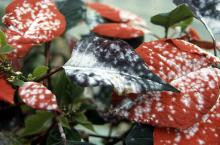See:
Greenhouse Plants, Ornamental - Powdery Mildew
Cause The fungus Pseudoidium poinsettiae was found in Oregon first in 1990. It has not been a big problem but left unchecked can spread very quickly. Many cultivars are susceptible. Spores are liberated from colonies under conditions of changing relative humidity. Spores can germinate within 6 hours at 68°F and establish an infection within 24 hours. However, temperatures above 85°F inhibit the process.
Symptoms Symptoms vary widely. They can be subtle on the leaf surface and are best seen on the leaf underside. Upper leaf surfaces may show only slight chlorosis in diffuse spots. Turning the leaf over can reveal a sparse to heavy mycelial growth that can be white to gray. Individual colonies will grow together until they merge and cover the surface of leaves or bracts. The disease easily is confused with spray residues on leaves or bracts, especially if using electrostatic sprayers.
Cultural control Early detection with regular scouting is very important.
- Space plants for good air circulation.
- Circulate the air in the greenhouse using fans.
- Keep relative humidity low.
- Scout plants weekly. On one out of 30 plants, inspect four fully expanded leaves in the middle of the plant. If powdery mildew is found, scout one out of 10 plants.
- Remove and destroy infected plant parts. (Seal in plastic before disposal so infected tissue does not move throughout the greenhouse.) The practice may not be practical or effective alone.
- It is thought that high greenhouse temperatures (greater than 85°F) may be used to help control an outbreak if powdery mildew occurs early in the production cycle.
Chemical control Apply immediately after finding the first colony. Wetting agents may be helpful. Many fungicides do not allow use after bract development. Tank-mix and/or alternate products with different modes of action to prevent the build-up of resistant fungi. Limit the use of any one group during crop production.
- Armada 50 WDG at 3 to 9 oz/100 gal water. Do not use a silicone-based surfactant. Not for nursery or greenhouse use. Group 3 + 11 fungicide. 12-hr reentry.
- Avelyo at 3 to 5 fl oz/100 gal water. Group 3 fungicide. 12-hr reentry.
- Bicarbonate-based products. Might be used to supplement a normal program when powdery mildew is first observed. Do not mix with acidifying agents. Thorough coverage is essential. O
- MilStop (85% potassium bicarbonate) at 0.25 to 0.5 lb/4350 sq ft. Do not use the high rate at weekly intervals when new leaves are developing as marginal burning may occur. Oregon and Washington only. 1-hr reentry.
- Monterey Bi-Carb Old Fashioned Fungicide at 4 teaspoons/2 gal water H
- Broadform at 2 to 4 fl oz/100 gal water. Group 7 + 11 fungicide. 12-hr reentry.
- Compass 50 WDG at 1 to 2 oz/100 gal water. Do not use organosilicate additives or after bract formation. Group 11 fungicide. 12-hr reentry.
- Eagle 20 EW at 6 to 12 fl oz/100 gal water. Group 3 fungicide. 24-hr reentry.
- Heritage at 1 to 4 oz/100 gal water plus a non-silicone-based wetter sticker. Group 11 fungicide. 4-hr reentry.
- Insignia SC at 3 to 6 fl oz/100 gal water. Do not use with organosilicate-based adjuvants. Use preventively only. Group 11 fungicide. 12-hr reentry.
- JMS Stylet Oil at 1 oz/1 gal water. Do not use during freezing temperatures, above 90°F, or when plants are wet or under heat or moisture stress. Do not use when foliage is wet as good coverage is essential. 4-hr reentry. O
- M-Pede at 2.5 oz/gal water. Sometimes phytotoxic, leaving yellow rings or a yellow stripe down the leaf midrib. Do not apply more than three (3) times. 12-hr reentry. O
- Myclobutanil 20 EW T&O at 6 to 12 fl oz/100 gal water plus spreading agent. May observe a PGR effect. Group 3 fungicide. 24-hr reentry.
- Pageant at 6 to 12 oz/100 gal water. Do not use with organosilicone-based adjuvants. Group 7 + 11 fungicide. Do not use for powdery mildew if used for Botrytis and vice versa. 12-hr reentry.
- Palladium at 4 to 6 oz/100 gal water. Avoid excessive runoff to small plants, which may result in stunting and/or chlorosis. Use of a nonionic surfactant may help reduce spray residue on bracts. Group 9 + 12 fungicide. 12-hr reentry.
- Phyton 27 at 1.5 to 3.5 oz/10 gal water. Results have varied. Group M1 fungicide. 48-hr reentry.
- Pipron at 4 to 8 fl oz/100 gal water. Spotting may occur on mature bracts. Greenhouse production only. Group 5 fungicide. 12-hr reentry.
- Seido at 4 to 5 fl oz/100 gal water plus an adjuvant. Group 50 fungicide. 4-hr reentry.
- Spectracide Immunox Multi-Purpose Fungicide Spray Concentrate for Gardens at 1 fl oz/gal water. Group 3 fungicide.H
- SuffOil-X at 1 to 2 gal/100 gal water. Do not use in conjunction with sulfur. Do not use when plants are under heat or moisture stress. 4-hr reentry.
- Terraguard SC at 4 to 8 fl oz/100 gal water. Group 3 fungicide. 12-hr reentry.
- Thiophanate-methyl-based products. Group 1 fungicides. 12-hr reentry.
- Cleary's 3336 EG at 12 to 24 oz/100 gal water. May leave a white residue.
- OHP 6672 4.5 F at 10 to 20 fl oz/100 gal water.
- Tourney EZ at 1 to 4 oz/100 gal water. Group 3 fungicide. 12-hr reentry.
- Triact 70 (neem oil) at 1%. Do not use with or close to sulfur applications. Group BM01 fungicide. 4-hr reentry. O
Biological control
- Cease or Rhapsody (Bacillus subtilis strain QST 713) at 2 to 8 quarts/100 gal water. Active ingredient is a small protein. Efficacy in the Pacific Northwest is unknown. 4-hr reentry. O
Reference Celio, G.J. and Hausbeck, M.K. 1998. Conidial germination, infection structure formation and early colony development of powdery mildew on poinsettia. Phytopathology 88:105-113.


